Last updated by: RichardWhellum, Last updated on: 09/05/2025
Data Warehouse Requirements
Document Creation: 19 May, 2024. Last Edited: 19 May, 2024. Authors: Kaleb, kghdxx.
Document Code: ARC1. Effective Date: 19 May, 2024. Expiry Date: 19 May, 2025.
Background
Redback Operations is currently without a permanent scalable contemporary data solution.
While workarounds currently exist, such as storing data in GitHub folders or on the personal computers of company members this is far from best-practice and doesn’t represent a sustainable longer-term solution.
While pervious work has been dedicated to a data warehouse solution and the ‘Project 4 - Data Warehousing Team’ is underway this trimester, both have given results with a focus on meeting short-term requirements in an ad-hoc fashion. These endeavours brought success for what was required under the constraints of a two-trimester unit and given the nature of the capstone program with the considerable budgetary and limited working hours. It is commendable the progress made so far is of such a high quality.
The purpose of this document is to present information on how data is currently used in Redback Operations and present a set of options which, if executed aim to improve the way data is to be used in the company.
Currently, data is sought out only when it is needed to be accessed, processed, utilized, and then most likely saved or discarded once it is no longer required. Within this process, includes a series of unnecessary steps which can be simplified or reduced, made more efficient, replaced or removed all together with a proper data model, data architecture, engineering, and data-lifecycle.
The first step, and that being the focus of this document and Project 4 is to establish what’s required from a potential Data Lakehouse. A proper best-practice data solution should not be acquiring hardware or software without considering and migrating across all records from existing storage solutions and continuing from there. Nor does it involve opening the gates for Junior and Senior company members to spin-up storage space, create and populate their own folders for storage without any guidance or overall modelling and data-lifecycle to ensure efficient use of resources. A Redback Operations data solution must begin with a cycle of planning as with any other project before jumping straight into a solution. While a data warehouse or data storage solution is a key component of the overall goal, to properly implement a data solution in line with an industry standard would mean a complete overhaul of the existing data processes for Redback (in some cases implementing for a lack of current data processes). This would consist of a body of work more akin to a ‘Data Transformation’ than a Data warehouse implementation.
While planning and implementing a project of this size given the timeframe would be ambitious for any company. A data transformation would require an introduction of many fundamental aspects typical of a high-functioning data department. This better ensures a solution foundation rooted in industry standards, including appropriate data architecture, data modelling, overall data framework, insights management and data security.
A Note on Data Warehouse
‘Data Warehouse Team’ is this company’s project allocated to a data storage solution, as has been the project objective since its inception.
The project name has been appropriate for general understanding given that practically yes, this project aims to implement a data storage solution, however; if any recommendation of this document is to be approved and bring the project up to industry standards and best practices, the projects objective would be looking to acquire and implement a state-of-the-art Data Lakehouse or similar company-wide data storage solution no longer a standalone Data Warehouse for one project alone.
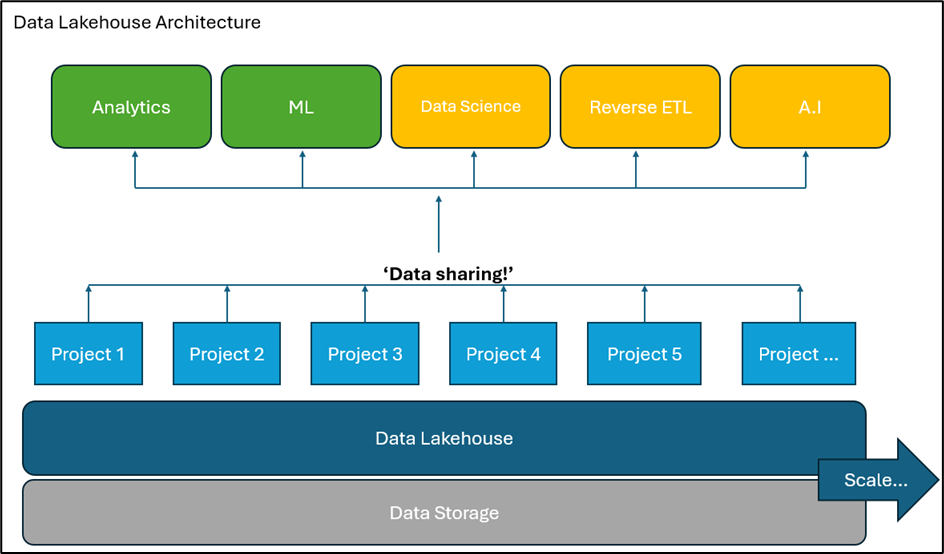
The Plan
A proposed data transformation requires input from a wide variety of stakeholders and would require a separate document.
A proposed plan may look like:
Requirements Gathering
Requirements gathering process including survey results and Requirements gathering document.
Assess current infrastructure
Gather information on the current data architecture/lack of.
Options paper, Choosing a platform
Storage layer
Platform
Options paper document
Design Architecture
Data ingestion Storage Processing Analytics Data governance
Data ingestion
Part of the platform decision
Data Storage
Virtual machine Cloud storage
Data Query and Analytics
Review tool stack for data analytics, Power BI, Tableau
Security and governance
Define access and encryption policies for sensitive data
Training and documentation
How-to’s and documentation Decision register Project retrospective
Requirements Gathering
The first stage of the data transformation involves requirements gathering, searching for pain points, and understanding how the company uses its data. Background documentation and consultation with company data stakeholders indicates prior requirements gathering has not been performed beyond a surface level and has been limited to the domain of Data warehouse leaders and some other key stakeholders.
Rigorous requirements gathering allows for an overall understanding of how the company uses its data, this in-turn gives a greater understanding of what is required to improve the data solution and helps to focus the scope when going to market for a SaaS solution or whether there is even need for a solution at all.
So far, as part of the requirements gathering process we have conducted five meetings with leaders from projects in the company.
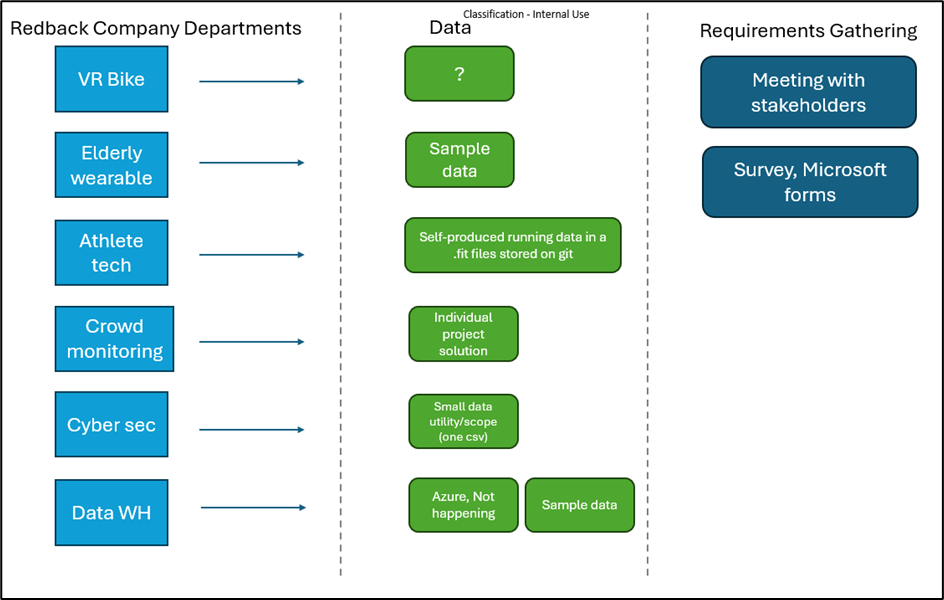 The current Redback company projects (Trimester 1 2024), their data and the upcoming requirements gathering
phases.
The current Redback company projects (Trimester 1 2024), their data and the upcoming requirements gathering
phases.
Pain Points
The results of a requirements gathering process at the beginning of Trimester 1 2024 indicate pain points of:
There currently isn’t an easy way to update the dataset for the various data analytics sources. Currently they must go through a GitHub fork/pull request.
The solution needs to have the capability to store unstructured, NoSQL objects and structured data.
Limited budget, subject to approval at all phases.
Preferably a more common language/low code approach for upskilling, due to high student turnover given nature of the capstone unit.
There is no central ‘repository’ for storing company wide data, adding steps to potential collaboration. No shared Data Lake that projects can derive insights from.
Individual user licenses present an obstacle every trimester, given student turnover.
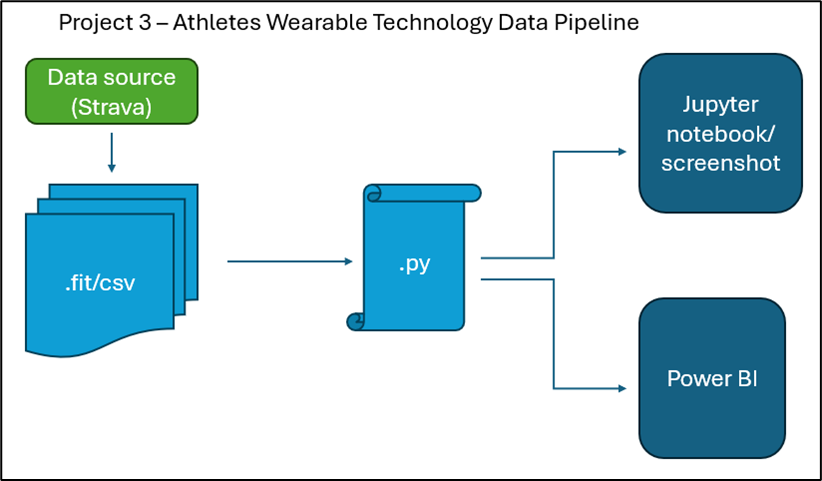 Project 3 Data Pipeline
Project 3 Data Pipeline
Requirements gathering is an ongoing process
A second requirements gathering exercise in the form of a survey is planned for Trimester 1 University week 6 (08/04/2024).

 Data Lifecycle comparisons
Data Lifecycle comparisons
So far, the pain points from the interview process alone can be summarized as requirements and favorable key features for a Data Lakehouse/Data solution. These become important to critique the suitability of options when choosing Redbacks Data Lakehouse.
➢ Large enough to support the current data storage requirements. ➢ Easily scalable to incorporate future projects and data requirements. ➢ Unstructured file storage, to support projects with object storage requirements. ➢ Cost effective, with a free trial or free forever tier to begin with. ➢ Ease of use and minimal upskilling will be favored. Commonality taken into consideration. ➢ Contemporary solutions, Redback Operations projects all have state-of-the-art objectives, and a data solution should be no different. ➢ Preferably an enterprise-wide solution not individual user-based licensing.
Survey
While company and project leaders have been consulted in meetings, end users will be offered a survey to gather how the majority of company members use data, mainly focused on members who aren’t directly involved in a data analysis/data science project. (Consultation of the Epic 2 - Data Analysis group is ongoing)
You can find the results from the week 6 survey here
The goal of the survey is to add to the overall requirements gathering process, namely how Redbacks company’s and non-data focused users currently use data, given the preliminary requirements gathered.
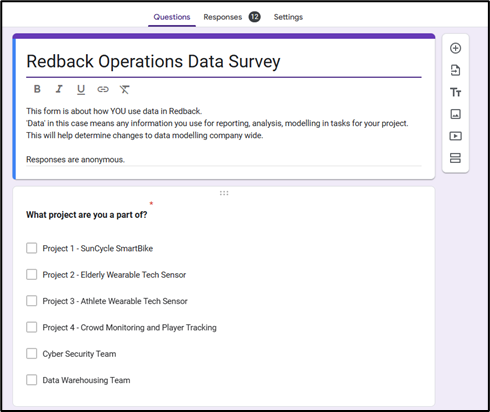
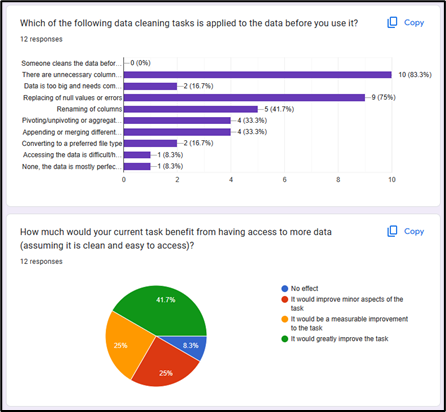
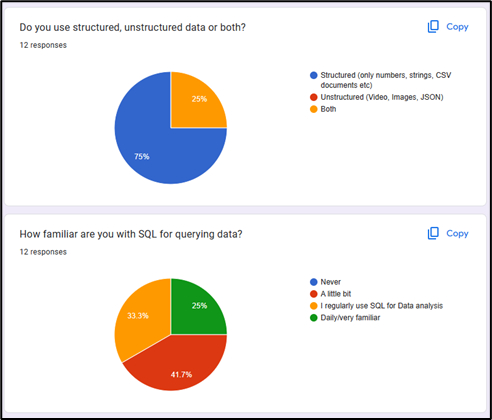
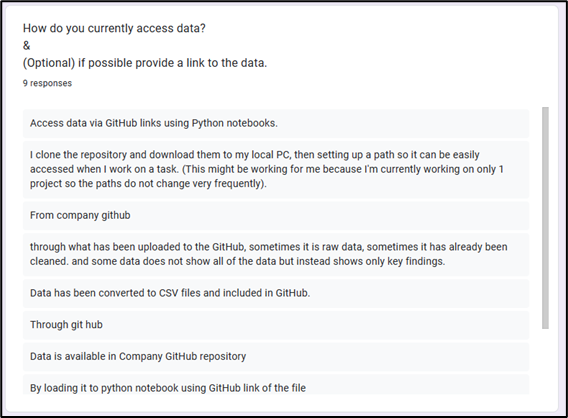
Options
The following options in this document represent a result of a formal process of requirements gathering through questioning and interviewing key stakeholders in Redback to assess pain points as well as researching industry leaders and trusted comparison companies, consultation from outside sources including industry professionals and individual set-up/testing each technology.
The six options in this document are the remainder of an initial field of which each option to qualify was required to meet at least a majority of requirements before each technology was tested to examine a potential use case further.
A final recommendation is planned to be provided after the results of the Requirements survey examined and the larger requirements gathering process concluded to maximize the information in making any decision.
 Summary table of Data Lakehouse options
Summary table of Data Lakehouse options
IOMETE
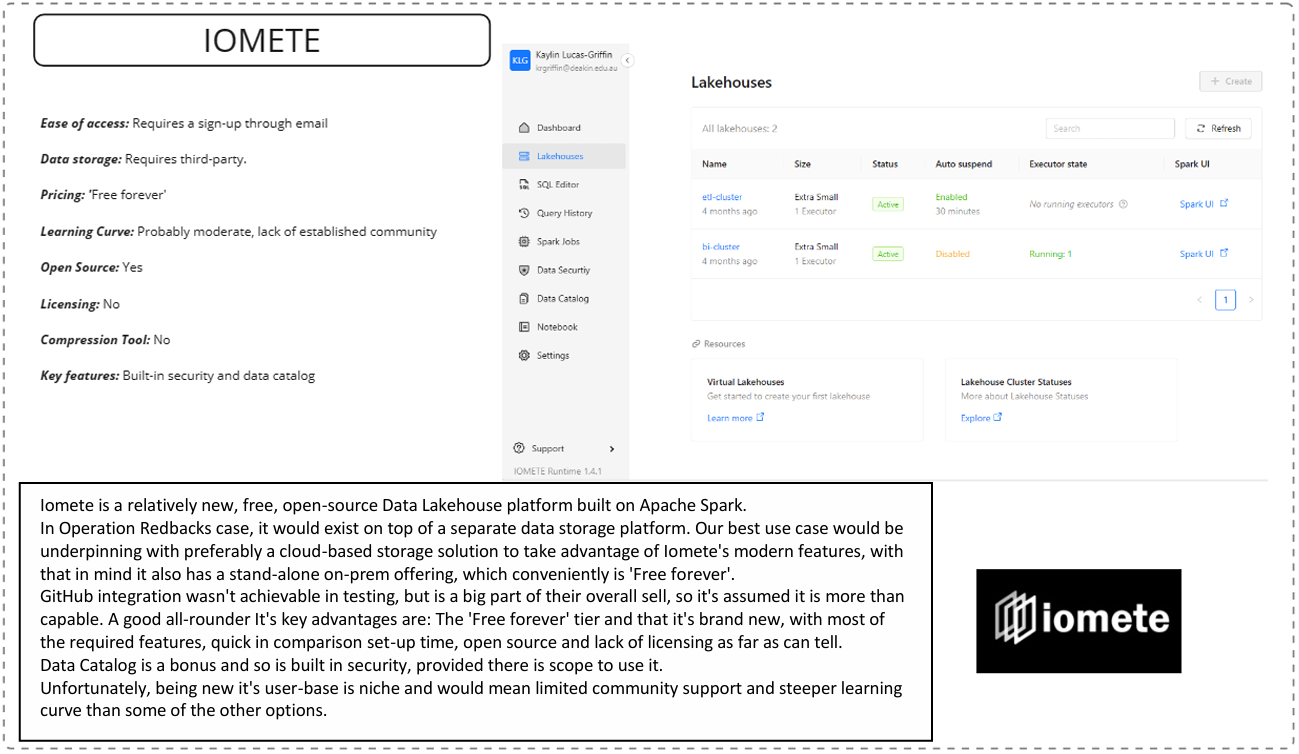
N8n
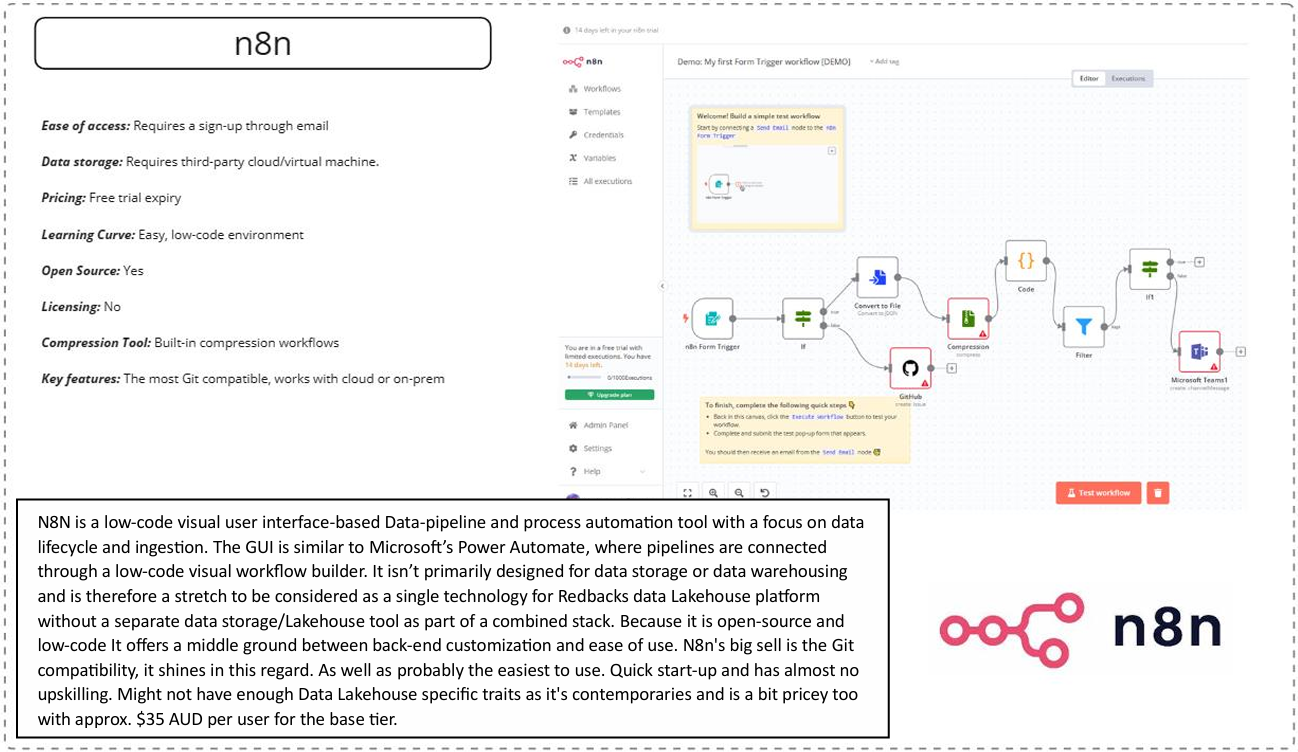
Dremio
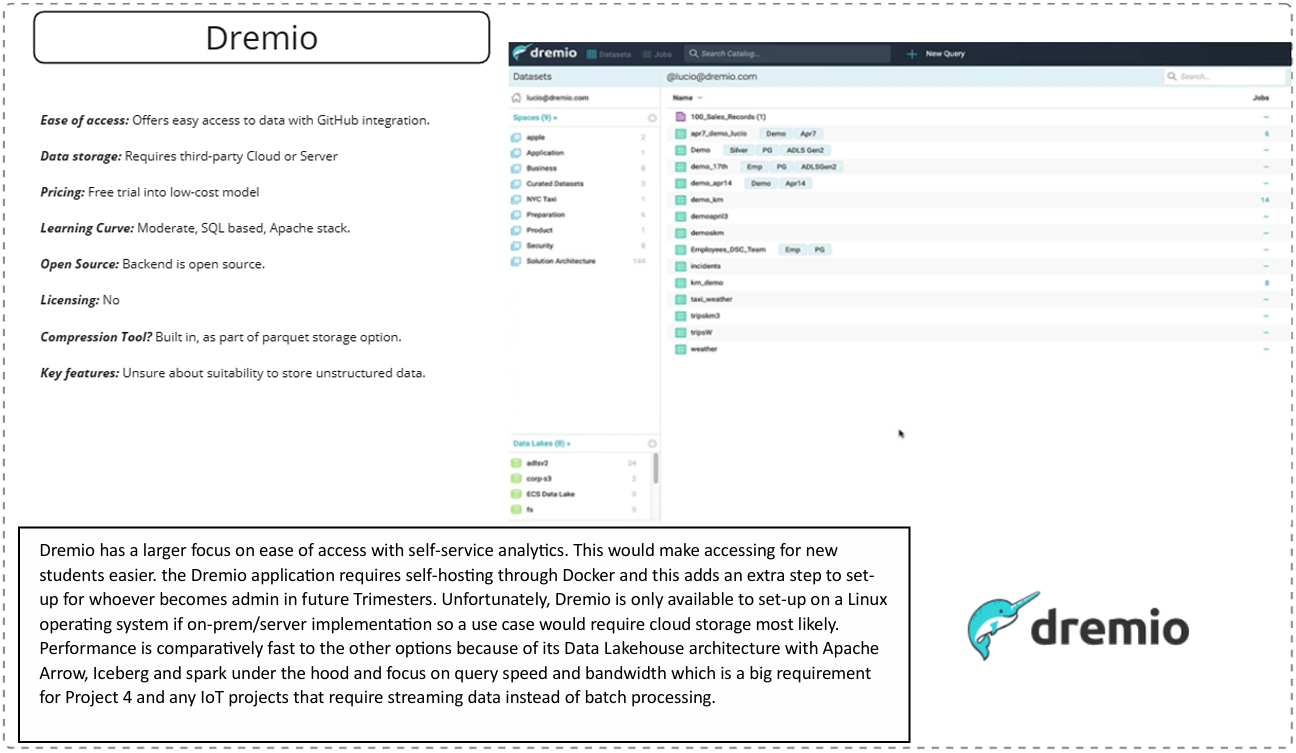
Microsoft Fabric/Azure

MongoDB
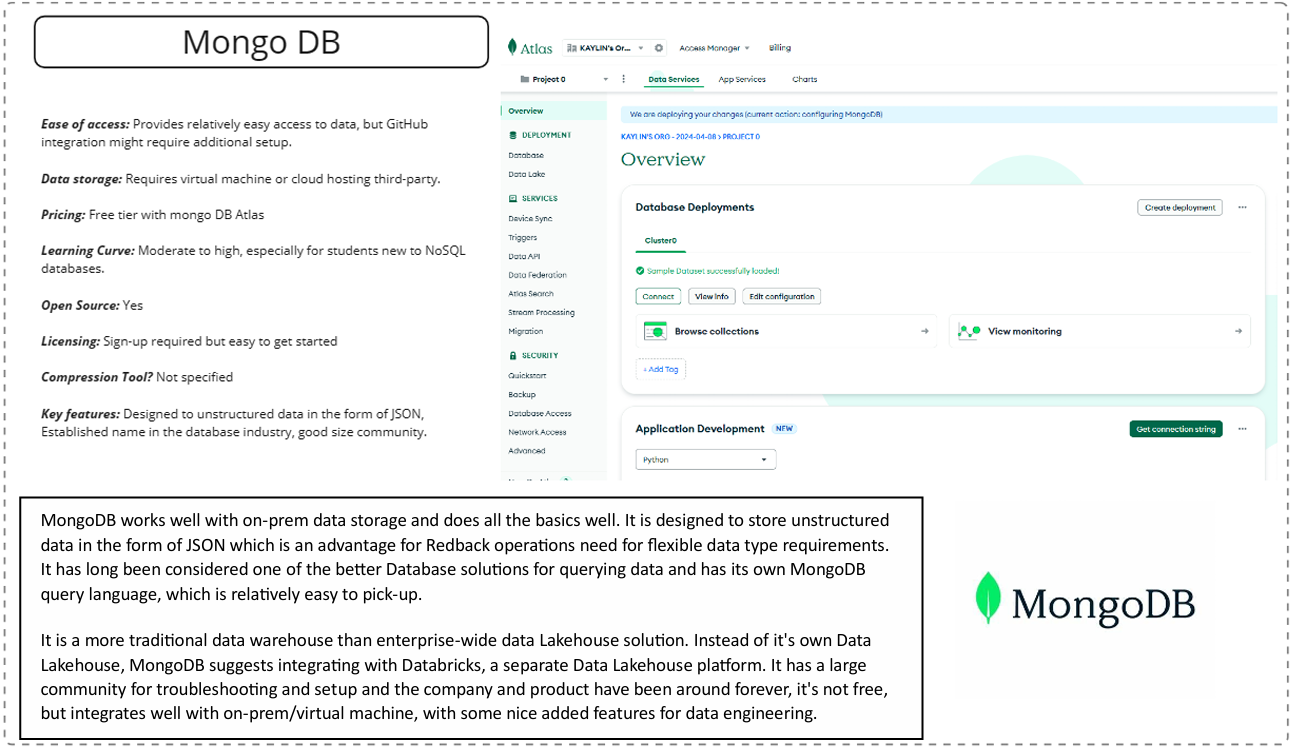
Apache Hudi
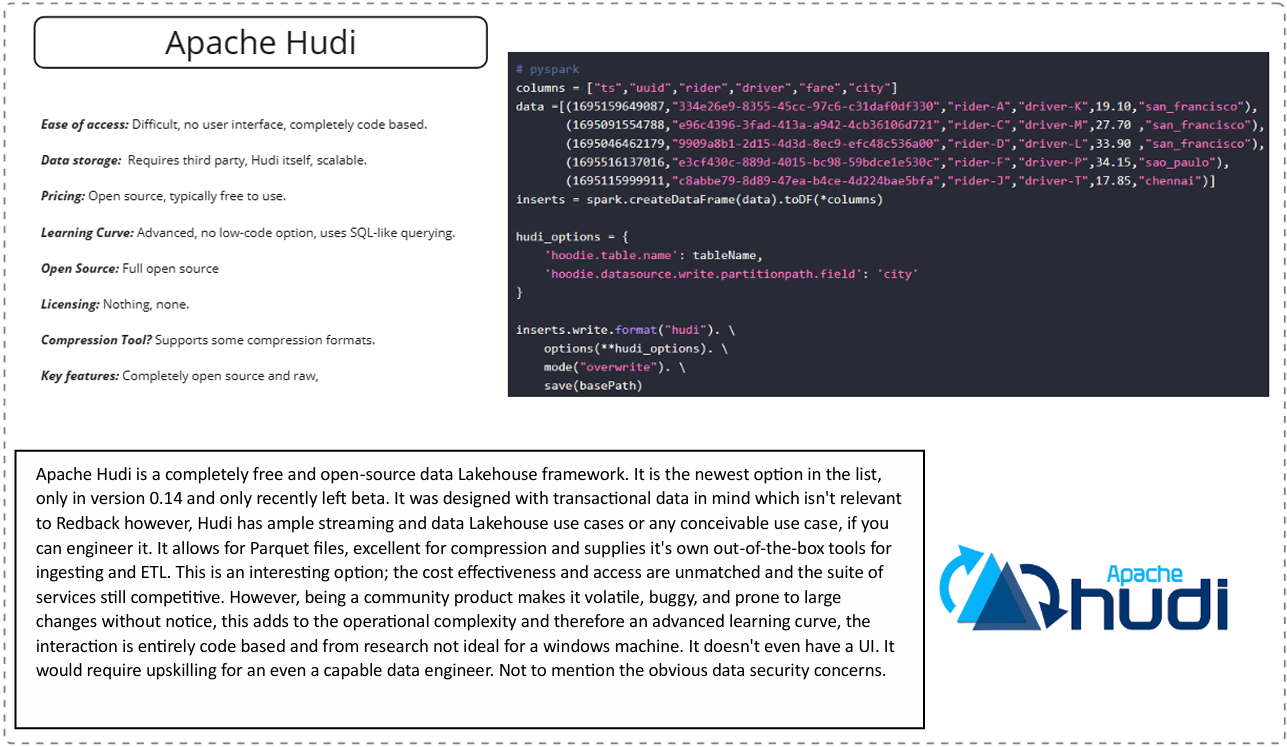
Data Storage
Data storage for the initial implementation of the Data Lakehouse platform will be the Deakin virtual machine, this will operate as BareMetal on-premises storage. In future Trimesters there is scope to secure funding for a cloud storage solution.